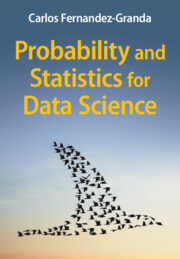Refine search
Actions for selected content:
52377 results in Statistics and Probability
Prevalence of Mollicutes in pregnant women undergoing high-risk prenatal care at a maternal and child reference unit in Bahia, Brazil
-
- Journal:
- Epidemiology & Infection / Volume 153 / 2025
- Published online by Cambridge University Press:
- 25 June 2025, e73
-
- Article
-
- You have access
- Open access
- HTML
- Export citation
A review of the environmental, social, and governance reporting among global pension plans and a proposed reporting framework
-
- Journal:
- British Actuarial Journal / Volume 30 / 2025
- Published online by Cambridge University Press:
- 25 June 2025, e20
-
- Article
-
- You have access
- Open access
- HTML
- Export citation
A large outbreak of invasive Group B Streptococcus Sequence Type 283 infection linked to physical contact of freshwater fish
-
- Journal:
- Epidemiology & Infection / Volume 153 / 2025
- Published online by Cambridge University Press:
- 24 June 2025, e76
-
- Article
-
- You have access
- Open access
- HTML
- Export citation
Rates for the SLLN for long-memory and heavy-tailed processes
- Part of
-
- Journal:
- Journal of Applied Probability , First View
- Published online by Cambridge University Press:
- 24 June 2025, pp. 1-21
-
- Article
- Export citation
The replicator coalescent
- Part of
-
- Journal:
- Journal of Applied Probability , First View
- Published online by Cambridge University Press:
- 24 June 2025, pp. 1-15
-
- Article
-
- You have access
- Open access
- HTML
- Export citation
MODEL AVERAGING FOR TREATMENT EFFECT ESTIMATION WITH HETEROGENEITY AND HETEROSKEDASTICITY
-
- Journal:
- Econometric Theory , First View
- Published online by Cambridge University Press:
- 24 June 2025, pp. 1-38
-
- Article
- Export citation
Control of an outbreak of invasive Group A Streptococcus in a care home in Lincolnshire, England
-
- Journal:
- Epidemiology & Infection / Volume 153 / 2025
- Published online by Cambridge University Press:
- 24 June 2025, e81
-
- Article
-
- You have access
- Open access
- HTML
- Export citation
Factors associated with lower COVID-19 vaccine uptake among populations with a migration background in the Netherlands
-
- Journal:
- Epidemiology & Infection / Volume 153 / 2025
- Published online by Cambridge University Press:
- 24 June 2025, e87
-
- Article
-
- You have access
- Open access
- HTML
- Export citation
Collective Defined Contribution (CDC): the route to effective pension scheme design
-
- Journal:
- British Actuarial Journal / Volume 30 / 2025
- Published online by Cambridge University Press:
- 23 June 2025, e21
-
- Article
-
- You have access
- Open access
- HTML
- Export citation
Risk factors for infection with SARS-CoV-2 in a cohort of Canadian healthcare workers: 2020–2023
-
- Journal:
- Epidemiology & Infection / Volume 153 / 2025
- Published online by Cambridge University Press:
- 23 June 2025, e72
-
- Article
-
- You have access
- Open access
- HTML
- Export citation
On contemporary mortality models for actuarial use I: practice
-
- Journal:
- British Actuarial Journal / Volume 30 / 2025
- Published online by Cambridge University Press:
- 23 June 2025, e18
-
- Article
-
- You have access
- Open access
- HTML
- Export citation
Stein’s method for distributions modelling competing and complementary risk problems
- Part of
-
- Journal:
- Advances in Applied Probability / Volume 57 / Issue 4 / December 2025
- Published online by Cambridge University Press:
- 23 June 2025, pp. 1510-1538
- Print publication:
- December 2025
-
- Article
-
- You have access
- Open access
- HTML
- Export citation
On contemporary mortality models for actuarial use II: principles
-
- Journal:
- British Actuarial Journal / Volume 30 / 2025
- Published online by Cambridge University Press:
- 23 June 2025, e19
-
- Article
-
- You have access
- Open access
- HTML
- Export citation
Accounting for edge uncertainty in stochastic actor-oriented models for dynamic network analysis
-
- Journal:
- Network Science / Volume 13 / 2025
- Published online by Cambridge University Press:
- 20 June 2025, e8
-
- Article
-
- You have access
- Open access
- HTML
- Export citation
Severe acute respiratory syndrome coronavirus-2 shedding in exhaled material: a systematic review
-
- Journal:
- Epidemiology & Infection / Volume 153 / 2025
- Published online by Cambridge University Press:
- 20 June 2025, e75
-
- Article
-
- You have access
- Open access
- HTML
- Export citation

Probability and Statistics for Data Science
-
- Published online:
- 19 June 2025
- Print publication:
- 03 July 2025

Spatial Analysis
- A Guide for Ecologists
-
- Published online:
- 19 June 2025
- Print publication:
- 03 July 2025
Mixture credibility formulas
-
- Journal:
- Annals of Actuarial Science , First View
- Published online by Cambridge University Press:
- 19 June 2025, pp. 1-15
-
- Article
-
- You have access
- Open access
- HTML
- Export citation
Bayesian adaptive trials for social policy – ERRATUM
-
- Journal:
- Data & Policy / Volume 7 / 2025
- Published online by Cambridge University Press:
- 19 June 2025, e43
-
- Article
-
- You have access
- Open access
- HTML
- Export citation
Extremal behavior of stationary marked point processes
- Part of
-
- Journal:
- Advances in Applied Probability , First View
- Published online by Cambridge University Press:
- 18 June 2025, pp. 1-42
-
- Article
- Export citation





